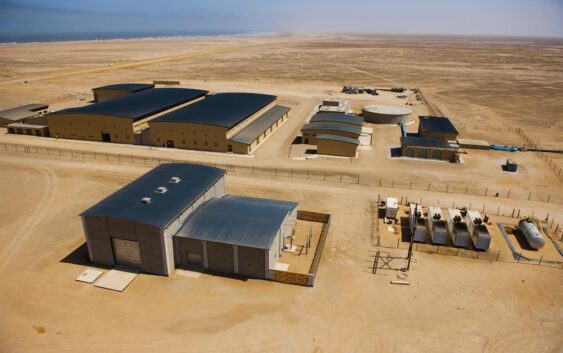- HOW TEMANE-MAPUTO ELECTRICITY TRANSMISSION LINE PROJECT IS GOING THROUGH TEST IN MOZAMBIQUE
- NAMIBIA INAUGURATED FIRST PLASTIC RECYCLING PLANTS
- PROGRESS MADE ON PIIM PROJECTS AS OVER 85% COMPLETED IN ANGOLA
- WORLD BANK KICK-OFF INSPECTION OF USMID PROGRAM IN UGANDA
- ALGERIA MINISTER RECIEVED HARBOR ENERGY CEO OVER ENERGY PARTNERSHIP
NAMIBIA GOVT. TO PROCURE SECOND MULTI-BILLION DOLLAR DESALINATION PLANT

Namibia government is set to proceed with the procurement of a second multi-billion-dollar desalination plant to be constructed at the coast in partnership with NamWater.
Agriculture minister Calle Schlettwein during the commissioning of water reservoirs by the RЪssing Uranium mine indicated the next step is to proceed with the procurement of the second desalination plant.
Plans for the second desalination plant have been in the pipeline after the government opted not to buy the Orano desalination plant at Wlotzkasbaken in 2016 due to its cost. The plant, at the time, was offered to the government by Areva for N$3 billion on the basis that such a utility cannot be privately owned.
The desalination plant supplies close to 50% of fresh water to the region’s consumption as well as several mines, including RЪssing Uranium. However, the rising water demand has forced the government to take a bold step forward and construct a second desalination plant at the coast.
“The feasibility study for the construction of a new desalination plant has been completed and shows that an additional desalination plant is viable and needed,” Schlettwein explained at Arandis.
He said the new plant will, therefore, be constructed by placing the project into a public-private partnership through which private capital will be leveraged and private operational capacity roped in.
According to Schlettwein, NamWater will remain the owner of the water. He also indicated government in collaboration with NamWater, is in the final stages and will soon start with the actual public-private partnership procurement stage.
“This will be a modular desalination plant facility, which is scalable to further supply desalinated water to the central areas and also to support water supply to Botswana at a later stage. Government, through NamWater, has also been working continuously to rehabilitate and replace the coastal pipeline network and developing new water schemes to increase capacity to ensure water supply security for the coast,” the minister elaborated.
He added they replaced the infrastructure of both groundwater resources that supply the western part of the country with water, which is from the Kuiseb River and Omdel Dam to Swakopmund. It now has a lifespan until 2037.

